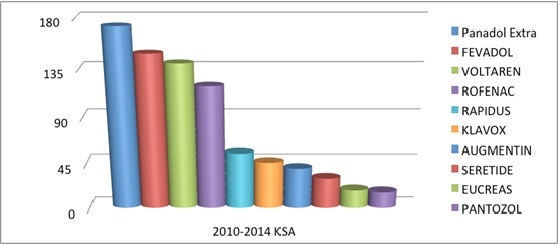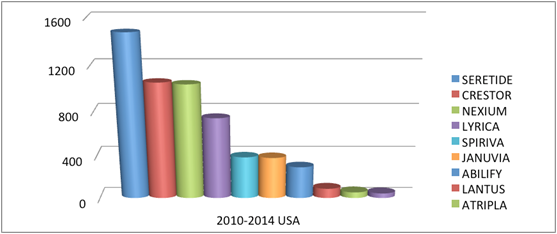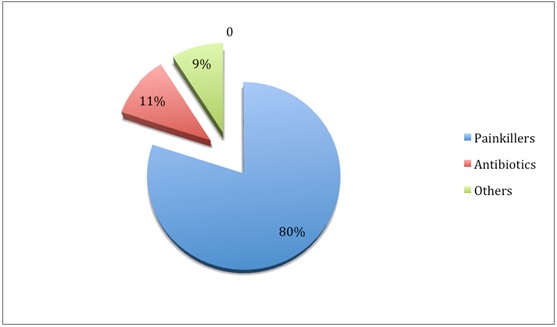
| Theme: Clinical Sciences 3 | |||
 |
||||||
| Top 10 used drugs in the Kingdom Of Saudia Arabia |
 |
|||||
|
||||||
KSA (The Kingdom of Saudi Arabia) is a populous country with a known history of high OTC (over-the-counter) drug use. Knowing the most utilized drugs amongst the population in Saudi Arabia may open the door to new areas of research. The first step is to determine drug use in KSA with actual figures.In this study, we want to determine the top ten drugs used in the Kingdom of Saudi Arabia. We would like to know if the kingdom is comparable to other world leading countries like the USA (United States of America) in regards of most utilized drugs amongst the population.
In this retrospective descriptive study, benchmarking is used as central instrument for the study, because it helps in identifying and implementing best practices as comparisons can be an important driver of performance. We used the intercontinental marketing services (IMS) Health drug database to determine the top 10 used drugs in the KSA. Our choice of comparison is the US as it is a leading country in healthcare services and many published papers regarding this subject have been covered in their country hence it is ideal for comparison.
The top used drug class in KSA was (Analgesics). This class represents 80% of the top used drugs in KSA. In all the years from 2010-2014 the top 5 Drugs were Analgesics except for 2011 where the top 4 were Analgesics. Those drugs are as follows: Panadol extra, Fevadol, Voltaren, Rofenac, Rapidus, Respectively. The second most used drug class In KSA were (Antibiotics) and this class represents 11% of the top used drugs in KSA. In all the year from 2010-2014 the 6th and 7th Drugs were Antibiotics and these drugs are: Augmentin, Klavox, Pantozol. Other Drug classes that where also in the top 10 used drugs in KSA where: SERETIDE (FLUTICASONE; SALMETEROL), EUCREAS (METFORMIN; VILDAGLIPTIN), And all these represent around 9% of the most utilized drugs.
In chart1. The median of the top 10 sold drugs in KSA from the years 2010 till 2014 (the volume unit is Millions).

Chart1.
The remarkable result was that no antibiotics were listed on the most utilized drug list of 2010 in the United States of America. To know the trend of the top 10 used drugs in USA between years 2010 till 2014 look at chart 2.
In chart2. The median of the top 10 sold drugs in USA from the years 2010 till 2014 (the volume unit is Millions).

Chart 2.
From our results we have found that Analgesics were the highest class of drugs used in the Kingdom (80% of the top 10 most used drugs in KSA). The second largest group was Antibiotics, with at least 2-3 antibiotics in the top ten list throughout the years the study was conducted. We believe that further control and regulatory actions regarding the use of antibiotics may have a better impact on the society.

[1]Vaccheri A, Castelvetri C, Esaka E, Del Favero A, Montanaro N. Pattern of antibiotic use in primary health care in Italy. Eur J ClinPharmacol. 2000;56:417–425. doi: 10.1007/s002280000165. [PubMed] [Cross Ref]
[2]Kumar R, Indira K, Rizvi A, Jeyaseelan L. Antibiotic prescribing practices in primary and secondary health care facilities in Uttar Pradesh, India. J ClinPharma Therap. 2008;33:625–634. doi: 10.1111/j.1365-2710.2008.00960.x. [PubMed] [Cross Ref]
[3]Costelloe C, Metcalfe C, Lovering A, Mant D, Hay AD. Effect of antibiotic prescribing in primary care on antimicrobial resistance in individual patients: systematic review and meta-analysis. BMJ. 2010;340:c2096. doi: 10.1136/bmj.c2096. [PubMed] [Cross Ref]
[4]Goossens H, Ferech M, Stichele R, Elseviers M. Outpatient antibiotic use in Europe and association with resistance: a cross-national database study. Lancet. 2005;365:579–587. [PubMed]
[5]Metz-Gereck S, Maieron A, Straub R, Wienger P, Apfalter P, Mittermayer H. Ten years of antibiotic consumption in ambulatory care: Trends in prescribing practice and antibiotic resistance in Austria. BMC Infectious Dis. 2009;9:61. doi: 10.1186/1471-2334-9-61. [PMC free article] [PubMed] [Cross Ref]
[6]Hall SA1, Chiu GR, Kaufman DW, Kelly JP, Link CL, Kupelian V, McKinlay JB.General exposures to prescription medications by race/ethnicity in a population-based sample: results from the Boston Area Community Health Survey. http://www.ncbi.nlm.nih.gov/pubmed/20140890
[7]K. A. Al Balushi, F. Al-Sawafi, F. Al-Ghafri,andI. Al-Zakwani.Drug utilization pattern in an Omani pediatric population. http://www.ncbi.nlm.nih.gov/pmc/articles/PMC3979272/
[8]Chai G1, Governale L, McMahon AW, Trinidad JP, Staffa J, Murphy D.
Trends of outpatient prescription drug utilization in US children, 2002-2010.http://www.ncbi.nlm.nih.gov/pubmed/22711728
[9]Suda KJ1, Hicks LA, Roberts RM, Hunkler RJ, Taylor TH.Trends and seasonal variation in outpatient antibiotic prescription rates in the United States, 2006 to 2010.http://www.ncbi.nlm.nih.gov/pubmed/24590486
[10]Grace C Lee12, Kelly R Reveles12, Russell T Attridge23, Kenneth A Lawson1, Ishak A Mansi4, James S Lewis12 and Christopher R Frei12*Outpatient antibiotic prescribing in the United States: 2000 to 2010http://www.biomedcentral.com/1741-7015/12/96
[11]Michiel B. Haeseker ,Nicole H. T. M. Dukers-Muijrers,Christian J. P. A. Hoebe,Cathrien A. Bruggeman,Jochen W. L. Cals,Annelies Verbon.Trends in Antibiotic Prescribing in Adults in Dutch General Practice.http://journals.plos.org/plosone/article?id=10.1371/journal.pone.0051860
[12]Christianne L Roumie, MD, MPH,1,2,3,4 Natasha B Halasa, MD, MPH,5 Carlos G Grijalva, MD,6 Kathryn M Edwards, MD,5 Yuwei Zhu, MD, MS,7 Robert S Dittus, MD, MPH,1,2,3,4 and Marie R Griffin, MD, MPH1,2,3,4,6.Trends in Antibiotic Prescribing for Adults in the United States—1995 to 2002http://www.ncbi.nlm.nih.gov/pmc/articles/PMC1490171/
[13] Ranji SR1, Steinman MA, Shojania KG, Gonzales R.Interventions to reduce unnecessary antibiotic prescribing: a systematic review and quantitative analysis. http://www.ncbi.nlm.nih.gov/pubmed/18665065

 Send Email
Send Email